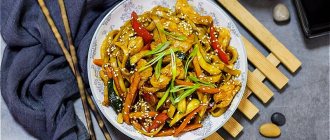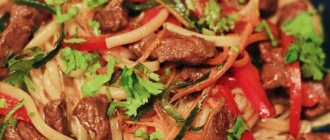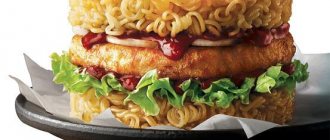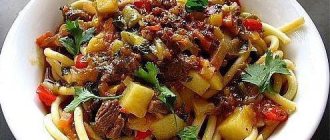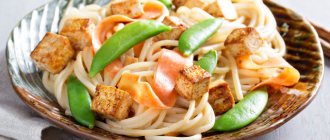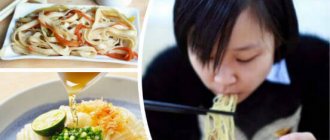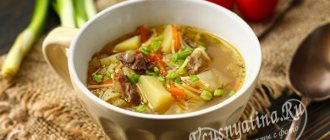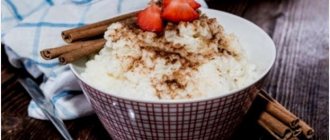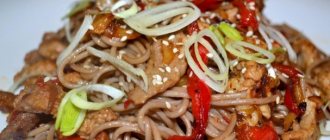This dish is prepared in almost every cafe and restaurant in the country and in many street food spots in Thailand. Pad Thai, like most other national dishes, contains a combination of four tastes: sweet, salty, sour and spicy, which is very typical for Asian cuisine. But all the tastes are not felt immediately, they are revealed gradually: first the sweet taste should be felt, then the sour one, and at the very end the sharpness should appear. It is the sequence of flavor development that is one of the criteria for properly prepared Pad Thai.
In general, Pad Thai combines many dishes that contain rice noodles, to which a variety of ingredients are added. The traditional recipe for the dish includes: rice flour noodles, shrimp or chicken, eggs, tofu cheese, mung bean sprouts, fermented fish sauce, tamarind sauce, chili pepper, onion, garlic, peanuts, lime.
There are many variations of Pad Thai depending on the ingredients used. But the indispensable ingredients of the dish remain rice noodles, meat, eggs, fish sauce and tamarind sauce. All other components are added from stock and upon request. Each chef adds ingredients to the dish at his own discretion, so Pad Thai in any Thai restaurant will have its own unique taste.
The process of preparing traditional Pad Thai is quite simple and does not take much time. All components are fried in a hot wok over high heat with continuous stirring, which reduces cooking time. Therefore, this dish has gained great popularity in the street cuisine of Thailand as a “fast food”.
Types of Pad Thai noodles
There are several options for ready-made Pad Thai. It is based on rice noodles, then various ingredients are added to it, on which the taste of the dish will depend. The choice of meat products that Thais add to Pad Thai is large. It could be chicken, pork, beef, shrimp, other seafood, or a combination of these.
The most popular is Pad Thai with chicken and shrimp, which has become a “classic” version of the dish. Therefore, if you decide to order Pad Thai, be prepared to be asked to clarify which dish you want to prepare.
Pad Thai with chicken
The most common version of the dish is rice noodles with chicken. It is liked by locals and is the leader of Thai cuisine among tourists. It is most popular in cities and areas of the Kingdom where there is no access to the sea for fresh seafood.
The chicken is cut into small pieces, placed in the pan first and fried for the shortest possible time in sizzling peanut oil. The secret of the dish is to bring the chicken to readiness in a record 5-10 minutes.
Pad Thai with shrimp
Shrimp Pad Thai is leading the charge in cities in Thailand that have direct access to the sea and can prepare fresh shrimp. Peeled and cooked shrimp are added to the dish. But sometimes they put in unpeeled ones, but then it’s not convenient to eat the dish.
Cooking according to the recipe:
- Place noodles in a large bowl and cover with cold water. Set aside until pliable and al dente, 45 to 60 minutes. Drain and dry well.
- Meanwhile, prepare the sauce
. Using your fingers, crush the tamarind paste into pieces and place in a small bowl. Pour 1/4 tbsp. boiling water and let it brew for 10 minutes. Mash with a fork to break up any clumps of paste, then press through a fine sieve (using a silicone spatula over a bowl), removing any seeds or tough bits. Add sugar, fish sauce and a pinch of salt, stir until smooth. - Heat a large cast iron skillet over medium heat. Pour 2 tbsp. l. vegetable oil, then add tofu, shallots, ginger and garlic. Cook, stirring with a flat wooden spoon, until tender (but not browned), about 2 minutes. Add the noodles and a few spoons of tamarind sauce. Cook, stirring and spreading the noodles around the pan until all the sauce is absorbed, about 1 minute. Add a few more teaspoons of tamarind sauce and fry for another 30 seconds. up to 1 min.
- Push the noodles to one side of the pan and add the remaining 1 tablespoon to the other. l. vegetable oil. Place shrimp in oil in a single layer and cook until half cooked (pink), 2-3 minutes. (Stir the noodles occasionally, making sure they don't stick to the pan). Add the remaining tamarind sauce and stir to combine the noodles and shrimp.
- Push the shrimp noodles to one side of the pan. Pour the eggs onto another, stir quickly, then leave undisturbed and let fry until almost done. Transfer the shrimp noodles to the eggs, then flip the whole thing over and divide the omelette into large pieces. Remove from heat, add bean sprouts and shallots, stir quickly (you want the bean sprouts and scallions to remain crisp). Divide among bowls, sprinkle with peanuts and serve with lime wedges. You can add marinated tofu instead of smoked tofu to Pad Thai.
Categories:
recipe / Lunch / Main courses / Pasta / Chinese noodles / Food Network - recipes / Thai cuisine
Required Ingredients
The following ingredients are used to prepare Pad Thai:
- rice noodles prepared by hand or machine from rice flour and water;
- meat: chicken, shrimp (fresh or dried), pork, beef, seafood or any other meat;
- eggs;
- hard tofu cheese made from soy milk;
- sprouted beans "Mash";
- complex fish sauce made from fermented fish;
- aromatic tamarind sauce;
- coconut sugar;
- hot red chili pepper;
- shallot;
- garlic;
- peanut;
- lime;
- seasonings
You may be interested in: Dangers of Thailand
Spicy seasonings such as chili peppers allow you to “disinfect” a dish. Fermented fish sauce has a light, specific aroma and gives the dish a subtle fishy taste. Coconut sugar adds a touch of sweetness, and unlike the better known cane and beet sugar, coconut sugar is healthier as it contains vitamin B and trace minerals.
The bitter taste comes from the addition of shallots and/or garlic. They are usually chopped very finely and their flavor dissolves into the finished dish. Tamarind pulp has a sweet and sour taste and perfectly dilutes the heat of chili. Tamarind is a fruit that resembles a date in appearance, has a seed and contains a large amount of vitamins.
Pad Thai has gained popularity for its extraordinary taste and ease of preparation. But at the same time, it contains only “healthy” products and no food “garbage”, so it can be safely classified as a “healthy” dish, which is important for people who watch their diet. Pad Thai in Thailand belongs to the “fast food” category, but unlike French fries, it is much healthier.
Recipe ingredients:
- 225 gr. flat Thai rice noodles
- 450 gr. Butterfly cut large shrimp with shell
- 1 pack (340 g) cubed 1 cm extra firm tofu
- 1/4 tbsp. fish sauce
- 1/4 tbsp. unrefined sugar or turbinado sugar
- 1 - 2 tbsp. l. hot Asian chili sauce (Sambal oelek or Sriracha)
- 2 tbsp. l. fresh lime juice plus lime wedges for garnish
- 1/4 tbsp. vegetable oil
- 4 large cloves garlic, chopped
- 6 radishes, thinly sliced
- 4 green onions, halved lengthwise and cut into 1-inch pieces
- 1/2 tbsp. coarsely chopped roasted salted peanuts
- 2 tbsp. bean sprouts
- 2 jalapeno peppers, seeded and thinly sliced (red and green)
Cooking rice noodles
Rice noodles are made from rice noodles and water. The mixture is kneaded, it quickly becomes thick and sticky, since rice contains a lot of starch. This produces rice dough from which noodles are made. Rice noodles, which are sold in stores and served in cafes, are made mechanized nationwide using noodle making machines.
Street cuisine is very popular in Thailand, and there are stalls with ready-made food on literally every corner. And the vast majority of street cooks prefer to prepare rice noodles by hand. They knead the dough and knead it for a long time, stretch, fold and stretch the rice dough again until it reaches the required consistency. Then they cut it into thin strips.
This is probably why street Pad Thai is so delicious and always a little different, because each chef prepares noodles in his own way. Raw noodles are placed in boiling salted water and cooked until almost done. So, the base of the dish - Pad Thai rice noodles - is created, after which the most creative and exciting process of bringing each dish to perfection begins: many ingredients are added to it.
Pad Thai recipe
The most time-consuming and labor-intensive step in making traditional Pad Thai is preparing the rice noodles by hand. If this stage is completed or machine-cooked noodles are purchased, everything else is much simpler and does not take much time. There are a great variety of Pad Thai recipes depending on the ingredients used.
Since Thais are not limited in their choice, which cannot be said about Europeans, for whom not all ingredients are available in stores, therefore Pad Thai prepared in Thailand will certainly differ from a dish prepared in Russia or Europe. Sometimes stores have specialized sections with Thai products, which will certainly make it easier to select the required ingredients.
But even in this case, the Thais use very fresh products, and the Europeans will have to be content with what they brought. For example, tamarind sold in a store will taste different from tamarind freshly picked in Thailand. But one way or another, Pad Thai can be prepared in Russia at home in the kitchen.
Ready-made Pad Thai sauce, which already contains tamarind, can help in obtaining the desired taste. This sauce can be bought in Thailand and brought home as a reserve, or you can buy it in Russian supermarkets, although its taste will still differ from the original. The taste of the dish will also be affected by the cooking time of different components and the order in which they are added to the pan. Try different recipes, look for your “own” unique one that you like best.
You may be interested in: Jackfruit - Indian breadfruit
Products:
- rice noodles 100-150 g;
- egg 2 pcs;
- Chinese cabbage - a small head;
- sprouted mung beans 1 cup (can be replaced with finely shredded white cabbage);
- tofu cheese 100 g;
- shrimp 100 g;
- peanut butter ¼ cup;
- peanuts ½ cup;
- tamarind paste 2-4 teaspoons;
- rice vinegar 2 tablespoons;
- honey ¼ cup;
- fish sauce (from fermented fish);
- lime 2 pcs;
- green onions;
- garlic - 1 clove;
- red hot chili pepper - to taste;
- lemon juice.
Subtleties of cooking
To prepare Pad Thai correctly, Thai chefs use some secrets:
- Mandatory use of a wok pan with a round bottom. It is better to take a deep frying pan with a small bottom diameter.
- The frying pan must first be heated up and hot.
- Cooked noodles are not washed with cold water. Add a spoonful of peanut butter to it to prevent it from sticking.
- Noodles are added to the sauce, but not vice versa.
- The finished dish is not salted; for a harmonious taste, the salt contained in the fermented fish sauce is enough.
Many tourists who try Pad Thai for the first time in Thailand fall so in love with its taste that later back home they feel an irresistible desire to try it again and again. Therefore, Pad Thai is sometimes compared to the effect of a drug, upon withdrawal of which the body suffers mentally and physically. Thai restaurants are not available everywhere, so you can try to cook Pad Thai at home yourself.
Making Pad Thai at home
- Place store-bought rice noodles in a deep bowl and pour boiling water over them until the water completely covers the noodles, leave for 5-7 minutes. During this time, the noodles should have time to get a little wet. Drain the water through a colander and add a spoonful of peanut butter to the remaining noodles to prevent them from sticking.
- Prepare the sauce. To do this, take tamarind paste, fish sauce, honey, rice vinegar, mix everything, pour into a saucepan, put on low heat, and cook a little. At the end, add chili pepper to taste, mix, turn off, and leave to cool.
- Pour peanut oil into a wok and heat it up high. When the oil begins to shine, it means that the desired temperature has been reached and you can add finely chopped green onions and garlic. Fry them for about a minute, add beaten eggs, mix.
- Add finely shredded Chinese cabbage and Masha sprouts (or finely shredded white cabbage). Fry constantly stirring. When the cabbage becomes soft, add tofu and shrimp.
- Fry further, the shrimp should become soft and the tofu cheese should be golden. And at the end, add the noodles, keep on fire for one or two minutes, stirring. Turn it off.
- Place the prepared dish on plates, sprinkle peanuts on top and place lime wedges. All is ready.
How to make Pad Thai with chicken
There is another Pad Thai recipe that uses chicken instead of shrimp. The cooking method will be slightly different.
- Pour boiling water over the rice noodles, wait, drain the water, add peanut oil, and stir.
- Chop the chicken breast fillet very finely so that it has time to fry quickly.
- Heat a wok, add sunflower oil, add finely chopped garlic, chicken pieces, fry until almost done over high heat, stirring constantly. The meat will remain in the pan until the end of cooking, so it will have time to cook.
- Move the chicken to the side, break two raw eggs into the center of the frying pan, fry it while stirring until you get a crumbly omelette. Mix with chicken.
- Add rice noodles, Pad Thai sauce, and all remaining ingredients. Fry for 1-3 minutes over high heat, stirring continuously. Turn it off. All is ready.
- Place on plates, sprinkle with peanuts, and add a little lemon or lime juice on top.
- You can add fresh cucumbers thinly sliced into strips or rings on top. You can eat it with a fork, but it is better with chopsticks to give the dish authenticity.
You may be interested in: Durian is the king of fruits
Cooking Pad Thai with chicken - step by step instructions
- Cut the chicken fillet into slices (thinner), or into strips.
- Soak rice noodles in warm water. Ten to twelve minutes will be enough.
- Pour vegetable oil (3 tablespoons) into a wok (or regular frying pan) and heat it.
- Add the crushed garlic with the flat side of a knife to the heated oil, and then the chopped garlic, lightly fry it.
- Fry the chicken fillet until done - the degree is determined by your own taste. This must be done quickly, so we increase the heat to the maximum. Since the meat is not removed from the pan until the end of cooking, it is better to undercook it a little.
- We move the meat to one half of the frying pan, and put a raw egg in the free space and fry it with continuous stirring. You should get a crumbly omelette.
- Mix the meat with the egg, add the soaked rice noodles. The degree of liquefaction of the latter is determined experimentally, but you must act according to the Italian principle: so that it is a little hard. To soak the noodles, we recommend using water heated to 60-70 degrees, although Thais most often use extremely cold water, which is why their noodles are not so soft.
- Add Pad Thai sauce and mix it thoroughly with the rest of the ingredients in the pan.
- Add greens - bean sprouts or thinly sliced cabbage leaves, green onions. If desired, you can add chopped carrots. Mix everything thoroughly. In a couple of minutes the dish is ready.
Portions of Pad Thai are placed on plates and sprinkled with crushed peanuts. Place half a lemon on top and sprinkle with lime juice to taste. The recipe for Thai Pad Thai noodles is very democratic, so you can replace the lemon with cucumber slices. This option can also be found in Thailand. Europeans eat Thai noodles with a fork, but it is better to do it with chopsticks.
How much does Pad Thai cost?
To try Pad Thai in Thailand, depending on the cafe you choose, you will have to pay 70-200 baht. This dish is not cheap. If you want to reduce the price, order Pad Thai without meat (chicken, pork, shrimp), this will greatly affect the cost of the dish. Pad Thai prepared in a makashnitsa will be cheaper (70-80 baht) than in a restaurant or cafe (150-200 baht), but will not be inferior in taste to the latter. In popular tourist places, the cost of the dish will be more expensive, and in rarely visited provinces you can buy Pad Thai for only 40-50 baht.
The cost of a dish prepared at home in Russia will be significantly higher than in Thailand, since the necessary ingredients, which you will have to buy in a store, are very expensive. For example, just a bottle of fish sauce costs about 200 rubles, tamarind paste costs 300-500 rubles, and a pack of rice noodles costs 150-200 rubles.
Many cafes offer takeaway food. If you eat in a cafe, they will bring you a plate of food and offer you a fork and chopsticks. If you want to take your food with you, it will be packed in a Styrofoam container to keep the food hot.
Where can you try Pad Thai?
Pad Thai is very popular in Thailand, so this dish is on the menu in almost all restaurants, cafes and many street food spots. To try this dish for the first time, the best option would be to go to a cafe and order it there. Sitting at a table in a cafe, you will better experience the aroma and harmony of the taste of Pad Thai. In addition, you can ask the waiter not to add chili pepper or any ingredients that you strongly dislike.
You can also buy Pad Thai in a street kitchen stall - in makashnits. Not all makashnitsa cook it; often one makashnitsa offers only one type of food. Pad Thai in a makashnitsa will be cheaper; it is prepared according to old traditional recipes passed down in the family to subsequent generations.
The only disadvantage of buying rice noodles in a makashnitsa may be “food poisoning” of the unprepared, delicate European stomach of a tourist. Street food sellers always use fresh products, since most of them work at their points throughout their lives, have regular customers among local residents and carefully monitor the reputation of their food.
The catch is that in the hot, humid climate of Thailand, produce and prepared food spoil very quickly, and therefore a lot of hot seasonings are added to food, which are “preservatives” that prevent rapid spoilage. Thais eat this kind of food from birth, their stomach gets used to the spiciness of the dishes. Europeans are generally not ready to eat such food, which can cause digestive problems.
You might be interested in:
Pitahaya (Dragon Fruit)
Pitahaya, or in other words, dragon fruit, is the fruit of the liana-shaped cactus Hylocereus, which grows in regions with a dry tropical climate. Plant…
Durian is the king of fruits
Durian is the king of fruits, hiding the most delicious and juicy pulp in the world behind its eerie appearance and disgusting smell. One of the most…
Maya Bay
Maya Bay is a small picturesque bay on the island of Phi Phi Le, which is part of the Phi Phi archipelago. The island itself is small, consists of…
Phuket
Phuket is the largest island in Thailand. It is located in the south of the country, washed by the Andaman Sea of the Indian Ocean. The area of the island is 540 km², which is 4 times...


